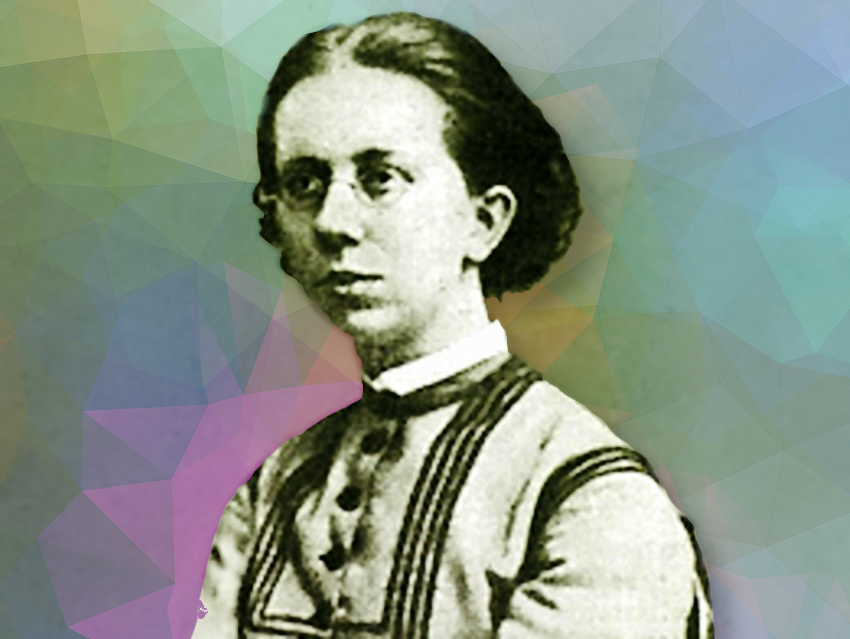Julia Vsevolodovna Lermontova was born on December 21, 1846, in St. Petersburg, Russia. Her parents made her education a priority. She developed an interest in science and conducted simple experiments at home. Initially, she wanted to study medicine, but did not have the stomach for it. She applied instead to Petrovskaia Agricultural College in Moscow, Russia, which had an excellent chemistry program, hoping to audit the classes. This was the most a woman could hope for at the time. However, her application was rejected.
Lermontova did not give up, in spite of the difficulties facing women at the time, and went abroad. She joined her friend Sofia Kovalevskaia, a a pioneer for women in mathematics in Heidelberg, Germany, in 1869. Kovalevskaia had convinced Lermontova’s parents to let the young woman stay with her. In Heidelberg, Lermontova joined the laboratory of Robert Bunsen, famous for the gas burner that bears his name, and worked on platinum compounds. That Bunsen admitted her is attributed to Kovalevskaia’s advocacy.
When Kovalevskaia moved from Heidelberg to Berlin, Germany, in 1871, Lermontova followed her friend. There, she worked in the laboratory of August Wilhelm von Hofmann and attended his lectures. Hofmann was an important organic chemist, as well as co-founder and first President of the German Chemical Society. At the beginning of 1874, she finished her doctoral dissertation in organic chemistry. There was some discussion on whether a woman could be allowed to graduate, and neither the University of Heidelberg nor the University of Berlin would allow it. Hofmann reached out to the more liberal University of Göttingen, Germany, where she successfully defended her thesis in 1874, graduating magna cum laude. This makes her likely the first Russian woman to receive a doctoral degree in chemistry.
Lermontova returned to Russia after her graduation. She worked in the laboratory of Vladimir Markovnikov in Moscow for a short time and then moved to St. Petersburg, where she found a job in the laboratory of the city’s university and studied branched olefins. On the recommendation of Dmitri Mendeleev, she became a Member of the Russian Chemical Society in 1875. For family reasons, Lermontova returned to Moscow in 1877 and rejoined Markovnikov. There, she worked on petroleum chemistry—likely the first woman in this field of study.
Lermontova had inherited a family estate in the countryside outside Moscow, and around 1886, she moved there permanently, stopped her chemical research, and turned her attention to agricultural sciences. Julia Lermontova died on December 16, 1919.
Julia Lermontova is the answer to Guess the Chemist (96).
Sources
- Julia Lermontova (1846–1919),
Marianne Offereins,
in European Women in Chemistry, Jan Apotheker, Livia Simon Sarkadi (Eds.), Wiley-VCH, Weinheim, 2011.
ISBN: 9783527636457 - Early Women Chemists in Russia: Anna Volkova, Iuliia Lermontova, and Nadezhda Ziber-Shumova,
Mary Creese,
Bull. Hist. Chem. 1998, 21, 19–24.
Selected Publications
- Ueber die Zusammensetzung des Diphenins (in German),
Julia Lermontova,
Chem. Ber. 1872, 5, 231–236.
https://doi.org/10.1002/cber.18720050172 - Zur Kenntniss der Methylenverbindungen (in German),
Julia Lermontova,
Doctoral dissertation, Göttingen, 1874. - Ueber die Einwirkung des tertiären Butyljodürs auf Isobutylen bei Gegenwart von Metalloxyden (in German),
Julia Lermontova,
Liebigs Ann. 1879, 196, 116–122.
https://doi.org/10.1002/jlac.18791960109
Also of Interest
- 125th Anniversary: Death of August Wilhelm von Hofmann,
ChemViews Mag. 2017.
Eminent organic chemist and first President of the German Chemical Society - 200th Birthday of Robert Wilhelm Bunsen,
ChemViews Mag. 2011.
Robert Wilhelm Bunsen did groundbreaking work in organic chemistry and spectrometry, but he’s most famous for the Bunsen burner




